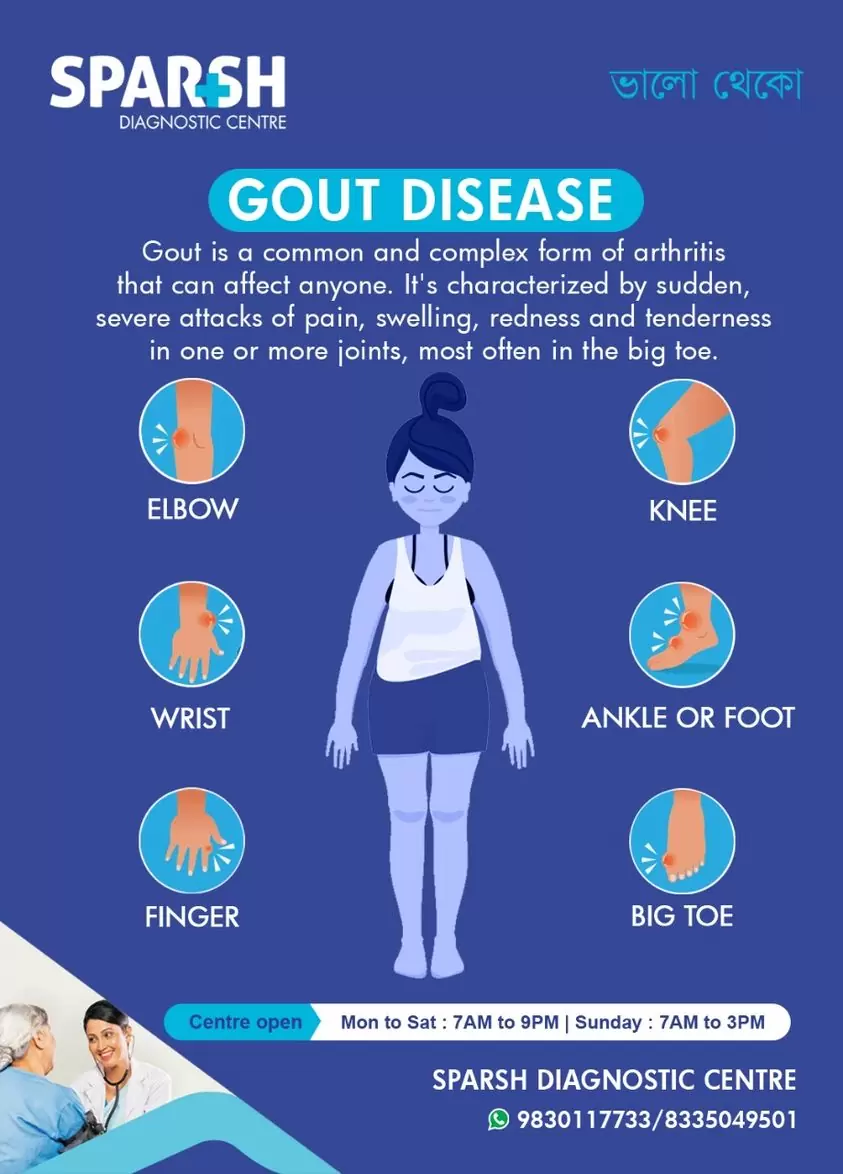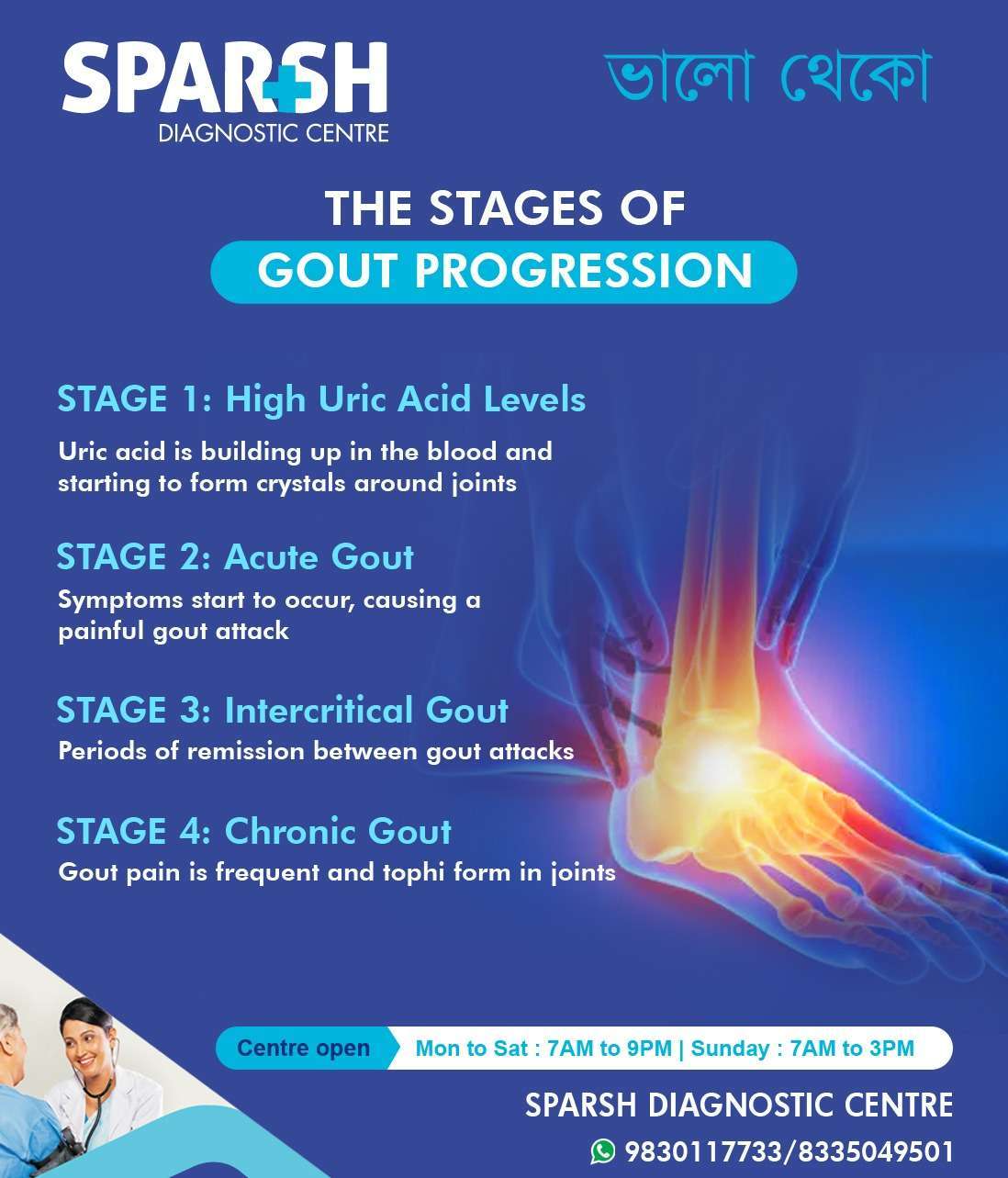Gout is a common yet complex type of arthritis that can cause sudden, severe episodes of pain, swelling, redness, and tenderness in the joints. It primarily affects the big toe but can also occur in the ankles, knees, elbows, wrists, and fingers. These painful flare-ups, known as gout attacks, often come unexpectedly and may recur over time, leading to long-term joint damage if left untreated.
With the rising incidence of lifestyle-related conditions such as obesity, high blood pressure, and kidney disease, gout has become more widespread. Understanding the causes, risk factors, stages, and available treatments is essential for early intervention and effective management.
What is Gout?
It is an inflammatory arthritis caused by the accumulation of uric acid crystals in the joints. Uric acid is a natural waste product formed when the body breaks down purines, substances found in foods like red meat, seafood, and alcoholic beverages. Normally, uric acid dissolves in the blood and is excreted by the kidneys. However, when the body produces too much uric acid or the kidneys fail to eliminate it efficiently, crystals form in the joints, triggering pain and inflammation.

The Stages of Gout Progression
It typically progresses through four distinct stages:
Stage 1: High Uric Acid Levels (Hyperuricemia)
Uric acid builds up in the blood.
No visible symptoms yet.
Crystals may silently form around joints.
Stage 2: Acute Gout
Sudden and intense pain in the affected joint.
Swelling, redness, and warmth around the joint.
Commonly occurs at night or early morning.
Stage 3: Intercritical Gout
Periods of remission between attacks.
Symptoms subside, but uric acid levels remain high.
Without treatment, attacks may return more frequently.
Stage 4: Chronic Gout
Frequent gout flare-ups.
Tophi (hard deposits of uric acid crystals) form in joints and soft tissues.
Permanent joint damage and deformity may occur.

Symptoms of Gout
The symptoms can vary but usually include:
Sudden, severe joint pain (especially in the big toe).
Swelling and tenderness in one or more joints.
Warmth and redness around the affected joint.
Limited range of motion.
Lingering discomfort after an attack subsides.
Commonly Affected Areas in Gout
It most often targets:
Big Toe – the most common site of gout flare-ups.
Ankle or Foot – causes difficulty in walking.
Knee – swelling and stiffness.
Elbow – pain and visible nodules.
Wrist and Fingers – less common but painful.
Causes of Gout
It results from excess uric acid buildup in the blood (hyperuricemia). Factors contributing to this include:
Diet: High-purine foods (red meat, shellfish, organ meats).
Alcohol: Especially beer and spirits.
Sugary Beverages: Drinks containing fructose increase uric acid levels.
Obesity: Higher body weight produces more uric acid.
Medical Conditions: Kidney disease, hypertension, diabetes.
Genetics: Family history of gout.
Medications: Diuretics, aspirin, and some blood pressure drugs.
Risk Factors for Gout
Certain factors increase the likelihood of developing the condition:
Gender & Age: Men are more prone; women are at higher risk post-menopause.
Family History: Genetic predisposition plays a role.
Unhealthy Lifestyle: Excess alcohol, fatty foods, and sedentary habits.
Chronic Illness: Conditions like metabolic syndrome and kidney disease.
Diagnosis of Gout
Doctors diagnose the condition using:
Medical History & Physical Exam – Assessing symptoms and joint involvement.
Blood Test – Measuring uric acid levels.
Joint Fluid Test – Detecting urate crystals in fluid from the affected joint.
Imaging Tests – X-ray, ultrasound, or dual-energy CT scan to identify urate deposits.
Treatment Options for Gout
Gout management involves both short-term relief during attacks and long-term prevention.
1. Medications
NSAIDs (Nonsteroidal Anti-inflammatory Drugs): Ibuprofen, naproxen.
Colchicine: Reduces pain and inflammation if taken early.
Corticosteroids: For severe pain and swelling.
Urate-Lowering Therapy (ULT): Allopurinol, febuxostat to reduce uric acid levels.
2. Lifestyle Modifications
Reduce alcohol and sugary drinks.
Stay hydrated to flush uric acid.
Maintain a healthy weight.
3. Home Remedies
Applying ice packs to inflamed joints.
Resting the affected area.
Elevating the joint to reduce swelling.
Complications of Untreated Gout
Without treatment, it can lead to:
Chronic Joint Pain: Permanent stiffness and deformity.
Tophi Formation: Hard lumps under the skin.
Kidney Stones: Due to uric acid crystal deposits.
Reduced Mobility: Affecting quality of life.
Prevention of Gout
While it cannot always be prevented, risk can be minimized through:
Maintaining a healthy weight.
Avoiding excessive alcohol.
Regular health checkups to monitor uric acid levels.
Living with Gout
Managing the condition requires both medical care and lifestyle adjustments. Many patients lead normal, healthy lives by:
Taking prescribed medication consistently.
Following a gout-friendly diet.
Avoiding known triggers.
Keeping regular follow-up appointments with doctors.
FAQs on Gout
Q1. What foods should I avoid if I have gout?
Avoid red meat, organ meats, shellfish, alcohol (especially beer), and sugary drinks.
Q2. Can it be cured completely?
Gout cannot be cured but can be effectively managed with medications and lifestyle changes.
Q3. Is it hereditary?
Yes, genetics play a role in uric acid metabolism and can increase gout risk.
Q4. How long does an attack last?
A gout attack may last from a few days to two weeks without treatment.
Q5. Can women get it?
Yes, though less common before menopause, women are at risk after menopause due to lower estrogen levels.
Q6. Can it cause permanent damage?
Yes, untreated gout can lead to chronic arthritis, joint deformities, and kidney stones.
Q7. What is the fastest way to relieve gout pain?
Taking prescribed medication (NSAIDs or colchicine), resting, and applying ice packs help reduce pain quickly.
Gout is a painful yet manageable form of arthritis. Early diagnosis, proper treatment, and healthy lifestyle changes are crucial in controlling gout attacks and preventing long-term complications. If you experience symptoms such as sudden joint pain, swelling, and redness, consult a healthcare professional for timely evaluation and management.
To consult a Doctor for treatment of gout, call Sparsh Diagnostic Centre at +91 9830117733.
#BhaloTheko
Disclaimer:
No content on this site, regardless of date, should ever be used as a substitute for direct medical advice from your doctor or other qualified clinician.
![]()






[…] Gout […]
[…] Existing Health Conditions: Rheumatoid arthritis, lupus, or gout. […]
[…] Too much insulin can make your kidneys less effective at removing uric acid, increasing your risk of gout. […]
[…] Seen in rheumatoid arthritis, lupus, or gout. […]
[…] a debilitating condition that affects day-to-day life. Among the many causes of joint inflammation, gout and pseudogout (also called Calcium Pyrophosphate Deposition Disease or CPPD) are two common […]
[…] health conditions, such as rheumatoid arthritis, diabetes, or gout, can increase the risk of […]
[…] Health Conditions: Conditions such as rheumatoid arthritis, gout, and diabetes can increase susceptibility to bursitis. Rheumatoid arthritis, for example, involves […]
[…] 3. Gout […]
[…] more prone to developing them. 6) Medical Conditions: Certain medical conditions such as gout, hyperparathyroidism and polycystic kidney disease can contribute to the development of kidney […]
[…] Gout: A form of arthritis caused by the buildup of uric acid crystals in the joints. Gout can cause sudden, severe knee pain, redness, and swelling, often affecting only one knee at a time. […]
[…] a condition known as hyperuricemia. High levels can lead to a variety of health problems, including gout, kidney stones, and even kidney disease. In this blog, we will dive into the causes, symptoms and […]